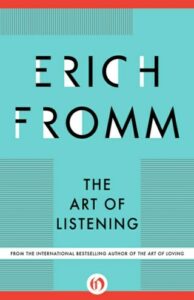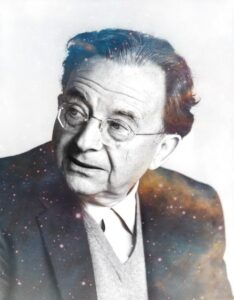Erich Fromm’s 6 Rules of Listening: The Great Humanistic Philosopher and Psychologist on the Art of Unselfish Understanding
INSPIRATIONAL, 10 Feb 2020
Maria Popova | Brain Pickings – TRANSCEND Media Service
“Understanding and loving are inseparable. If they are separate, it is a cerebral process and the door to essential understanding remains closed.”
 “An experience makes its appearance only when it is being said,” wrote Hannah Arendt in reflecting on how language confers reality upon existence. “And unless it is said it is, so to speak, non-existent.” But if an experience is spoken yet unheard, half of its reality is severed and a certain essential harmony is breached. The great physicist David Bohm knew this: “If we are to live in harmony with ourselves and with nature,” he wrote in his excellent and timely treatise on the paradox of communication, “we need to be able to communicate freely in a creative movement in which no one permanently holds to or otherwise defends his own ideas.”
“An experience makes its appearance only when it is being said,” wrote Hannah Arendt in reflecting on how language confers reality upon existence. “And unless it is said it is, so to speak, non-existent.” But if an experience is spoken yet unheard, half of its reality is severed and a certain essential harmony is breached. The great physicist David Bohm knew this: “If we are to live in harmony with ourselves and with nature,” he wrote in his excellent and timely treatise on the paradox of communication, “we need to be able to communicate freely in a creative movement in which no one permanently holds to or otherwise defends his own ideas.”
How to do that is what the influential humanistic philosopher and psychologist Erich Fromm (March 23, 1900–March 18, 1980) explored in a 1974 seminar in Switzerland, the 400-page transcript of which was eventually adapted into the posthumously published The Art of Listening (public library).
Listening, Fromm argues, is “is an art like the understanding of poetry” and, like any art, has its own rules and norms. Drawing on his half-century practice as a therapist, Fromm offers six such guidelines for mastering the art of unselfish understanding:
- The basic rule for practicing this art is the complete concentration of the listener.
- Nothing of importance must be on his mind, he must be optimally free from anxiety as well as from greed.
- He must possess a freely-working imagination which is sufficiently concrete to be expressed in words.
- He must be endowed with a capacity for empathy with another person and strong enough to feel the experience of the other as if it were his own.
- The condition for such empathy is a crucial facet of the capacity for love. To understand another means to love him — not in the erotic sense but in the sense of reaching out to him and of overcoming the fear of losing oneself.
- Understanding and loving are inseparable. If they are separate, it is a cerebral process and the door to essential understanding remains closed.
In the remainder of the The Art of Listening, Fromm goes on to detail the techniques, dynamics, and mindsets that make for an optimal listening relationship, in therapy and in life. Complement it with Ursula K. Le Guin on the magic of real human communication and Alain de Botton on what makes a good communicator, then revisit Fromm on the art of living, the art of loving, how to transcend the common laziness of optimism and pessimism, and the key to a sane society.
_______________________________________
 Brain Pickings is the brain child of Maria Popova, an interestingness hunter-gatherer and curious mind at large obsessed with combinatorial creativity who also writes for Wired UK and The Atlantic, among others, and is an MIT Futures of Entertainment Fellow. She has gotten occasional help from a handful of guest contributors. Email: brainpicker@brainpickings.org
Brain Pickings is the brain child of Maria Popova, an interestingness hunter-gatherer and curious mind at large obsessed with combinatorial creativity who also writes for Wired UK and The Atlantic, among others, and is an MIT Futures of Entertainment Fellow. She has gotten occasional help from a handful of guest contributors. Email: brainpicker@brainpickings.org
Go to Original – brainpickings.org
Tags: Erich Fromm, Inspirational
DISCLAIMER: The statements, views and opinions expressed in pieces republished here are solely those of the authors and do not necessarily represent those of TMS. In accordance with title 17 U.S.C. section 107, this material is distributed without profit to those who have expressed a prior interest in receiving the included information for research and educational purposes. TMS has no affiliation whatsoever with the originator of this article nor is TMS endorsed or sponsored by the originator. “GO TO ORIGINAL” links are provided as a convenience to our readers and allow for verification of authenticity. However, as originating pages are often updated by their originating host sites, the versions posted may not match the versions our readers view when clicking the “GO TO ORIGINAL” links. This site contains copyrighted material the use of which has not always been specifically authorized by the copyright owner. We are making such material available in our efforts to advance understanding of environmental, political, human rights, economic, democracy, scientific, and social justice issues, etc. We believe this constitutes a ‘fair use’ of any such copyrighted material as provided for in section 107 of the US Copyright Law. In accordance with Title 17 U.S.C. Section 107, the material on this site is distributed without profit to those who have expressed a prior interest in receiving the included information for research and educational purposes. For more information go to: http://www.law.cornell.edu/uscode/17/107.shtml. If you wish to use copyrighted material from this site for purposes of your own that go beyond ‘fair use’, you must obtain permission from the copyright owner.
